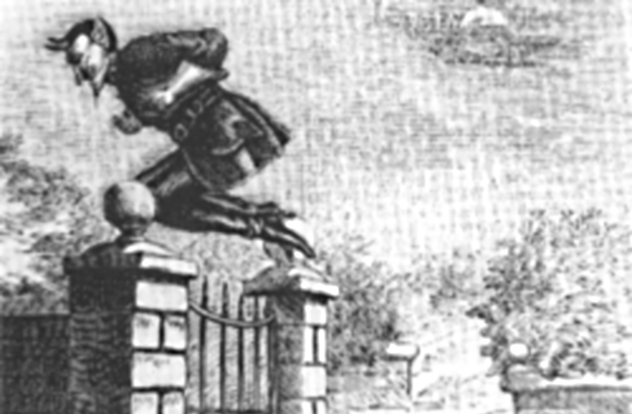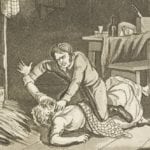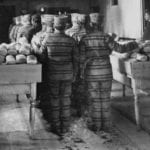 History
History  History
History  Weird Stuff
Weird Stuff 10 Superstitious Beliefs That Once Consumed Entire Cultures
 History
History 10 Bizarre Friendly Fire Incidents in Military History
 Technology
Technology 10 Modern Technologies That Accidentally Imitate Ancient Magic
 Mysteries
Mysteries 10 Mysteries of the Human Genome
 Weird Stuff
Weird Stuff 10 Things So Rare They’ve Only Been Found Once
 History
History 10 Legends Whose Last Moments Undid Their Glory
 Health
Health 10 Futuristic Ideas to Treat Common Medical Problems
 Weird Stuff
Weird Stuff Ten Surreal Attempts to Reverse Baldness
 Facts
Facts 10 U.S. Government Contingency Plans for the Unthinkable
 History
History 10 Odd Things Colonial Americans Kept at Home
 Weird Stuff
Weird Stuff 10 Superstitious Beliefs That Once Consumed Entire Cultures
 History
History 10 Bizarre Friendly Fire Incidents in Military History
Who's Behind Listverse?

Jamie Frater
Head Editor
Jamie founded Listverse due to an insatiable desire to share fascinating, obscure, and bizarre facts. He has been a guest speaker on numerous national radio and television stations and is a five time published author.
More About Us Technology
Technology 10 Modern Technologies That Accidentally Imitate Ancient Magic
 Mysteries
Mysteries 10 Mysteries of the Human Genome
 Weird Stuff
Weird Stuff 10 Things So Rare They’ve Only Been Found Once
 History
History 10 Legends Whose Last Moments Undid Their Glory
 Health
Health 10 Futuristic Ideas to Treat Common Medical Problems
 Weird Stuff
Weird Stuff Ten Surreal Attempts to Reverse Baldness
 Facts
Facts 10 U.S. Government Contingency Plans for the Unthinkable
10 Of The Most Bizarre Accounts From The 19th Century
Strange and unexplained events have happened throughout history. Although we’ve learned much about our world and universe that has explained away many oddities of the past, enigmas still remain. Strange occurrences, mysterious crimes, and events with no clear explanation have occurred. Here are a few from the 19th century, though where truth ends and fiction begins is anyone’s guess.
10 For Whom The Bell Tolls

Around 2:00 AM on August 6, 1801, Sir Jonah Barrington, an Irish judge, lawyer, and politician, and his wife experienced an event that they never forgot. Lord Barrington awoke to a soft sound that seemed somewhere between a voice and music. For some reason, the sound filled him with dread, and he awoke his wife, who also heard the sound. As it slowly grew louder and more plaintive, they got out of bed and tried to determine where it was coming from, but the sound seemed to be coming from everywhere at once. When they stood in front of a window looking onto their garden, the sound suddenly seemed to be coming from an empty patch of grass just below the window.
After about 30 minutes of this strange crying, a deep, sobbing sigh issued out, followed by the distinct call: “Rossmore! Rossmore! Rossmore!” Then, all was silent. The Barringtons returned to bed; Lady Barrington tried to come up with a myriad of explanations, and finally made her husband promise not to speak of the matter to anyone else. At 7:00 AM, Lord Barrington was awoken by a loud rapping at his chamber door. A servant had terrible news: though seemingly of fine health, a near neighbor and family friend, Lord Rossmore, had died at 2:30 AM.
9 Strange Tidings

Around 1830, on the island of Benbecula, Scotland, a woman who wanted to wash her feet at the reef found herself looking at a “creature in the form of a woman in miniature” swimming in the calm sea, in close proximity to her. She called her friends, and soon a group of people watched the odd creature as it swam about and made somersaults. Some of the men tried to wade out to the animal, but it started to swim away. Then some boys threw stones at it, and one of them struck the creature square in the back. A few days later, its dead body was found on a beach 3.2 kilometers (2 mi) away.
Crowds of people came to see the creature. It was described as being the size of a well-fed three- or four-year-old child, with abnormally developed breasts, long, dark, glossy hair, and white skin that was very soft. The lower part of her body was like a salmon, but without scales. In other words, she was a mermaid. The body was buried with all respects in a small coffin near the shoreline where it was found.
8 The Leaping Terror

In 1838, Victorian imagination was fired up by the exploits of a daring troublemaker, dubbed “Spring-Heeled Jack” for his tendency to escape by jumping hedges and vanishing into the countryside. On January 8, the Lord Mayor publicly read a letter that he received, which warned of a person dressing up and scaring people in the villages to the east of London. The Lord Mayor then announced flatly that this person should not try their tricks in London proper, or the police would have them.
On the evening of February 20, young Jane Alsop answered a furiously ringing bell to see a policeman down by the gate, who called for a candle. He claimed to have caught Spring-Heeled Jack! Jane ran the candle out to the officer, who held it up to reveal a hideous countenance as he vomited blue flames at her and then assaulted her with iron claws. With the help of her sisters, Jane was pulled back into the house. When a call went out for the police, Jack turned and bounded off.
As police scrambled to find suspects, Jack struck again. On February 28, two young women, sisters, were walking home and turned down an alley. Lucy Scales, the younger sister, was a bit ahead of her sibling when a figure stepped from a dark corner and spurted blue flame right into her face. As Lucy’s sister tried to help her, this unknown person simply walked away from the scene. In both cases, police arrested and questioned many people, but nothing came of these efforts. The true identity of Spring-Heeled Jack is still unknown.
7 Truth Wins Out

In 1859, Sam Slick made the first public note of an odd situation that had begun in 1821 in the village of Montgomery, England, which lasted about 100 years. In 1821, a man named John Newton was accused by two men, named Parker and Pearce, of attempting a highway robbery. On their word alone, Newton was found guilty and sentenced to death. Newton had only moved to the town two years previously and had few friends, but he was a diligent bailiff at the Oakfield manor house and had saved the owners from losing the estate to debt. He had also apparently attracted the attentions of the daughter of the household, though they were not publicly a couple. When asked if he had any reason why he should not be found guilty, Newton replied to the effect that he knew there was nothing he could say or do that would convince the court of his innocence or the falseness of the testimonies against him, so he would most certainly die. However, as proof of his innocence, Newton earnestly prayed to Heaven that for the length of at least one generation no grass should grow upon his grave.
Newton was indeed found guilty and was executed and buried in the Montgomery churchyard. The grave remained free of grass. When another author, S. Baring-Gould, visited the grave in 1903, he found it was still devoid of grass. As for the men who accused Newton, Parker’s ancestors had once owned Oakfield, and he hoped to gain it with Newton out of the way; Pearce had his eye on the daughter of the family and also wanted Newton out of the way. Parker became a dissolute drunkard, eventually dying in a blasting accident at a limeworks, and Pearce, realizing the woman would never have him, became despondent and wasted away.
6 Toad In The Hole

On the morning of April 7, 1865, workmen digging a tunnel through magnesium limestone in Hartlepool, England, broke up a large stone and discovered that it contained a cavity which perfectly fit its contents: a toad. The toad immediately started to move and, after some effort, started to breathe and make a loud “barking” noise, which it made whenever it was touched.
Examination showed that the toad’s mouth was sealed; the barking noise was made by its nostrils. The animal had the claws of its forefeet turned inward and had hind claws that were much longer than the then-common British toads. The stone it was freed from was found 7.6 meters (25 ft) below the surface, and at least 2.4 meters (8 ft) from any spring water vein. The toad continued to live for some time and was examined by a number of people. One of them, Rev. Robert Taylor, was of the opinion that the toad must be around 6,000 years old to be found in the rock it inhabited!
5 Unidentified Flying Discs

On November 4, 1867, something strange was happening in the skies above Chatham, England. Unidentified flying objects appeared from 3:00 PM–4:00 PM, in plain daylight, around the area of the town reservoir and were seen by multiple people. Black discs, too many to count, in groups and scattered about, were passing rapidly through the air.
They were visible for at least 20 minutes and appeared similar to large cannon shot as they passed the Sun. However, they were possibly not a solid substance, as they were also seen to disappear suddenly, both individually and in groups, leaving only puffs of gray-brown vapor like smoke. Witnesses wrote to Symon’s Monthly Meteorological Magazine both to report the matter and to ask what it could have been, but the editor had no answer for them. No proven explanation exists.
4 A Providential Dream

Dr. E.A. Wallis Budge was head of the Egyptian Antiquities Department of the British Museum for over 30 years and author of many influential books on the history of the ancient Egyptians. When Budge was still just a student at the University of Cambridge in England, he had a chance to be in charge of a lucrative exhibition, but it depended upon him passing an examination to test his skill with the ancient Assyrian language.
The night before the test, Budge had a dream. In it, he was seated in a small room with a skylight in the roof. A man entered and handed him a paper to translate for the test. Budge knew he’d seen the text before but couldn’t translate it; he awoke from the dream in a frightened state. Budge then had the same dream two more times. Unable to sleep after that, he lit a fire and grabbed a book of Assyrian texts to read. In it, he found that some of the texts looked very similar to what he had seen in his dream. A mixture of curiosity and sleeplessness saw Budge spend the rest of the night working at translating this text, and by morning he had a reasonable English version.
When Budge went to be tested that morning, he was informed that the main testing hall was full due to a large classical literature exam, so he was shown to a quiet side room near the kitchen. It was small with a skylight in the roof. The man handling the examination then presented Budge with his test, which proved to be exactly the same text that Budge had spent several hours translating. Budge got the exhibition.
3 The Woman In Black

A well-documented haunting occurred from 1882–92 in a large house in Cheltenham, England. In 1882, the family of Captain Frederick William Despard moved into the house. Shortly after, Rosina Despard heard a noise outside her door one night and opened it expecting to find her mother. Instead, there was a ghostly woman dressed in black holding a handkerchief up to her face.
This first encounter inspired Miss Despard to investigate; she attempted to talk to the ghostly figure a few times, but the woman in black apparently couldn’t answer back. When Despard tried to touch the woman, she was never able to feel anything. In fact, the woman in black was seen to walk through thin strings placed across the stairs without breaking them. Twice, the small dog of the house was seen to rush to the stairs excitedly, as if expecting to be petted, only to suddenly tuck its tail between its legs and hide under the sofa. Though not everyone in the house saw the woman in black, they all heard footsteps in parts of the house that no one was in.
In 1885, loud noises sometimes occurred for no reason and door handles started to move on their own, which frightened away many servants, but by 1892, even the footsteps had stopped, and the haunting was apparently over. Investigated by the Society for Psychical Research, Miss Despard’s notes on the matter were published in the society’s journal under the false family name of “Morton,” to prevent curiosity seekers from bothering the family more than the ghost had.
2 Unidentified Flying Creature

Strange news was reported by the local paper of Tombstone, Arizona, on April 26, 1890. Two ranchers returning home from the Huachuca Mountains ran across a gigantic monster resting on the desert floor. The creature was later described as resembling a huge alligator with a very long tail and immense, leathery wings. When the creature saw the men approaching, it took to the air but clearly appeared to be exhausted. The men gathered their wits (and their rifles) and set off in pursuit of the fantastic, flying beast. When they got close enough to the animal, they began to shoot it. The creature turned on the men, but it was unable to catch them and was eventually killed by the ranchers’ persistent gunfire.
Examination showed the creature’s body to measure 28 meters (92 ft) long, with a wingspan of 49 meters (160 ft). The entire body was hairless and featherless, and the skin was smooth and “easily penetrated by a bullet.” The men planned to skin the beast, and a number of prominent citizens of Tombstone rode out to see the carcass before it was mutilated. Nothing more was ever heard of the beast. Was it a hoax? Or, as some people have postulated, did the cowboys shoot down a surviving pterosaur?
1 Lost

Bertha Huse had gone missing. On the morning of Saturday, October 1, 1898, she had walked out of her home in Enfield, New Hampshire, before the rest of the household had awakened, and neighbors saw her headed for Shaker Bridge. As the day stretched into afternoon and she didn’t return, her alarmed family called for a search. Hundreds of men scoured the nearby woods and lakeshores over the weekend. With no clues found, a diver was sent for and started to search the lake, especially around and under the nearby Shaker Bridge. All day Tuesday and Wednesday he searched, but no evidence of the missing woman was found.
On Wednesday evening, Mrs. Titus, a woman living 6.4 kilometers (4 mi) away from Enfield, had a strange dream. She awoke in a sort of trance; her husband, frightened, shook her fully awake, and she complained that “In a moment I should have found that body.” She fell asleep, and again awoke in the trance later that night. This time, her husband quietly questioned her about what she was seeing. Mrs. Titus would only respond to questions regarding the missing Bertha Huse. Mrs. Titus saw that Huse had walked out onto the bridge and stepped onto a jutting beam. The beam was covered with white frost, and Huse had slipped and slid into the timberwork under the bridge. Her body, Mrs. Titus asserted, was head-down under the bridge, in a spot where only one shoe could be found.
On Thursday, Mr. & Mrs. Titus went to Enfield to talk to the diver, who checked where Mrs. Titus specified. The body of Bertha Huse was found, 5.5 meters (18 ft) deep in complete darkness. She was head-down in a hole with just one shoe sticking out, obscured by weeds, and only locatable by touch.
Garth Haslam has a degree in Anthropology and specializes in folklore and religious studies. He’s been digging into strange topics for over 30 years and posts his research on varying anomalies, curiosities, mysteries, and legends at his website, Anomalies: the Strange & Unexplained.








